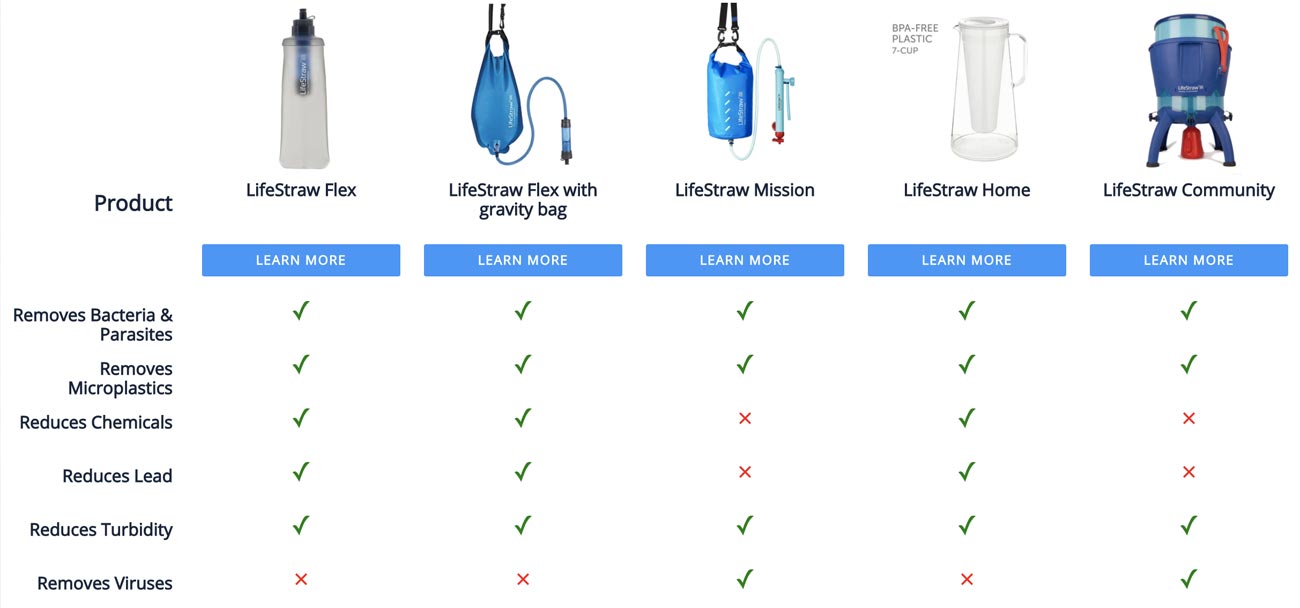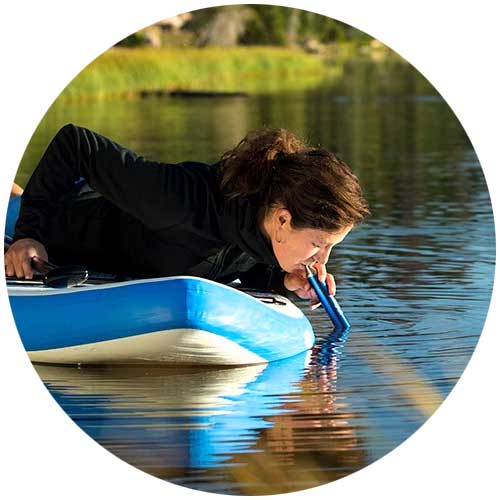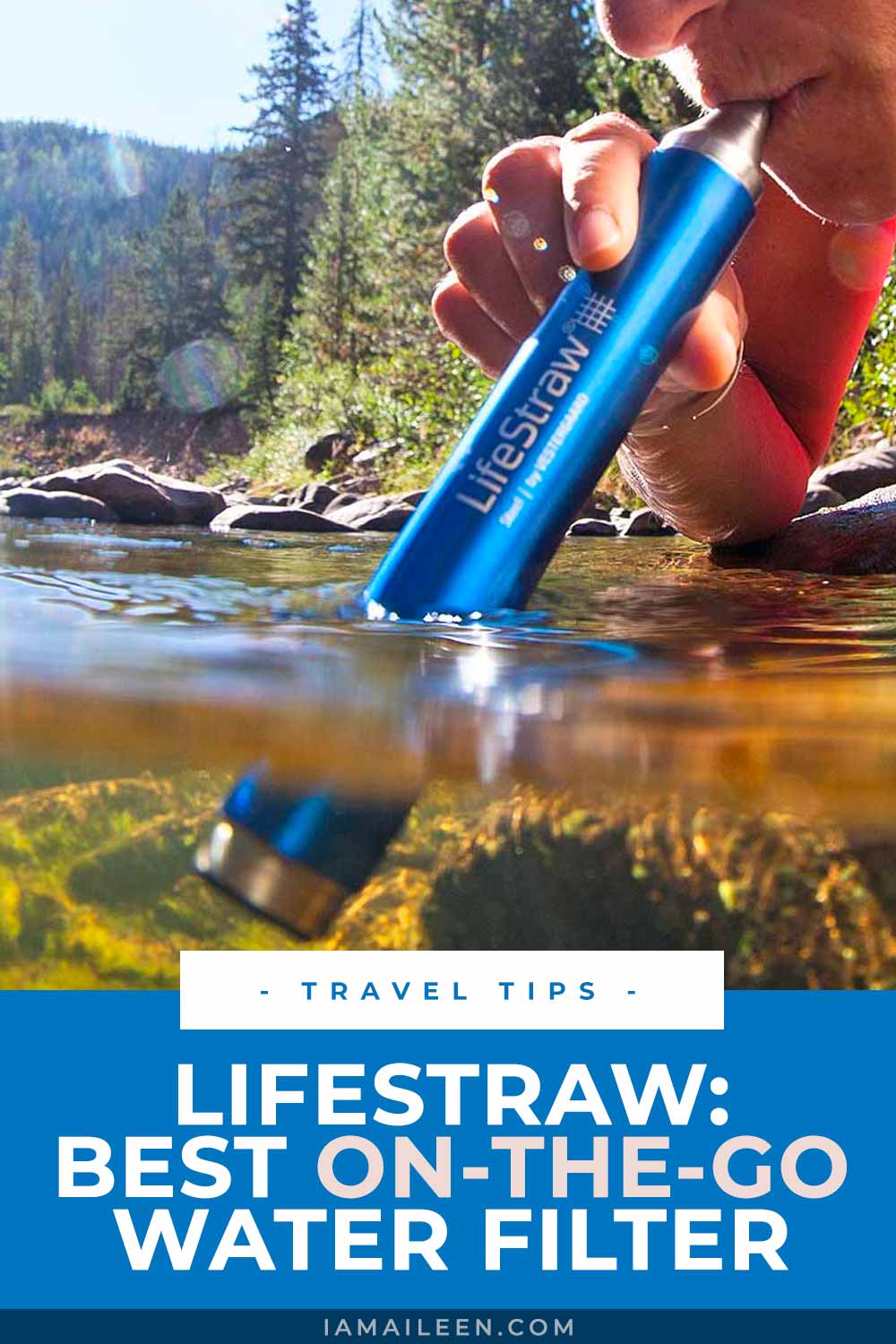Have you ever gone on a long hike or expedition, and you suddenly found yourself running out of water…? If you’re lucky enough to find a water source along the way, you can drink it to quench your thirst; however, you will not be assured of its safety. After all, us humans have managed to contaminate and pollute most groundwater, rivers, springs, and lakes! (Lifestraw Filter)
Given such situations, it is naturally a smart move to bring along a water filter and/or purifier, no matter if you’re trekking out in the wild or simply venturing out to foreign cities.
What other items are a must to pack for your travels?
Check out this list of useful travel items!
Some of the many ways that you could purify questionable water (such as that in your camping site, your hotel room, etc.) are through pumping filration items, iodine tablets, and the good ol’ boiling method — but my problem with these methods is that they are respectively tedious, bad-tasting, and time-consuming!
So when I was given the chance to try out the LifeStraw filter which could potentially answer all of my previous problems, I was more than willing to give it a try… and after months of trying it out on hikes and even on simple day trips to cities and towns that could possibly have dirty water, guess what?
I fell smitten with it.
Today, the LifeStraw filter has truly become one of my travel essentials and here’s why!
What is LifeStraw?
LifeStraw is a whole product line built with powerful water filtering technology and it is manufactured by Vestergaard Frandsen, a Switzerland-based company specializing in disease control products for developing countries.
“At LifeStraw, we believe everyone deserves safe drinking water. Our intent to meet this basic human need is what drives us to build our products.”
– – –
LifeStraw Filter Product Varieties
Apart from offering their products to worldwide consumers, LifeStraw has also since been shipping to places all throughout the world, especially to countries in need including Haiti, Pakistan, and Africa.
To date, they have the following LifeStraw product varieties.
Depending on your needs, there are a lot of LifeStraw products that can be of use to you!
– – –
Why I Love LifeStraw?
- They have different varieties that are well-made. LifeStraw has incorporated state-of-the-art technology to ensure your safety; from membrane ultrafilters to activated carbon and ion exchange filtration, they got all the bases covered for you! What’s more, not only are they durable but they are also easy to clean, store, and use. (It actually has no shelf life, so you can store it indefinitely!). Their main varieties are namely:
- LifeStraw Personal Water Filter (basic): $19.95 ~ This is made of durable plastic that contains no chemicals, uses no batteries, and is BPA-free.
- LifeStraw Steel Water Filter: $54.95 ~ Made of food-grade stainless steel that meets the U.S. Food and Drug Administration’s regulations and standards. This is almost the same as the basic LifeStraw bit with a sleek steel exterior and 2-stage water filtration process that can even protect against chemicals.
- Other than the LifeStraw Go, the LifeStraw Steel is my favorite among their product line because of how nifty it is for travel and hikes!
- LifeStraw Go: $28.94 ~ This is basically a basic LifeStraw water filter that is incorporated into a sports bottle so that when you’re on a long hike, for example, and are not sure when you would find a water source again, you can just easily store the fluids with this thing. (Of course, you can just use your own water bottle partnered with the basic LifeStraw).
- LifeStraw Family 1.0 and LifeStraw Community: $57.96 and $329.95 ~ this is more for large volume water purifications (for expeditions, camping, hiking in groups, communities, etc.) with more stringent features like removing viruses.
.
- They are affordable and well-priced with advanced water filter systems. To illustrate…
- The most basic of the LifeStraw series can already give you the following benefits:
- Filters up to 4,000 liters (1,056 gallons) of water
- Removes 99.9999% of waterborne bacteria (>LOG 6 reduction), including E-Coli
- Removes 99.9% of waterborne protozoan parasites (>LOG 3 reduction), including Giardia & Cryptosporidium
- Reduces turbidity (cloudiness or muddiness of water) and particulates (dirt), filtering down to 0.2 microns
- Does NOT use iodine or iodinized resin and has a very high flow rate — this means that it will have no bad aftertaste like what you might normally get from iodine tablets
- Whereas the LifeStraw Steel will give you added features like the following:
- Reduces chlorine
- Reduces organic chemical matter (Pesticides, Herbicides, VOC)
- Meets U.S. EPA drinking water standards
- A 2-stage water filtration process
- Hollow fiber membrane: with a lifetime of 4,000 liters (1,056 gallons) that can do the same functions as basic LifeStraw
- Activated replaceable carbon capsule: with a lifetime of 400 liters (105 gallons) that reduces chemicals such as chlorine while also reducing organic compounds (including pesticides and herbicides), odor, and bad taste.
.
- The most basic of the LifeStraw series can already give you the following benefits:
- Great for emergencies and overall preparedness.
- For the outdoors, whenever you’re unsure of water safety while camping or hiking, LifeStraw has you covered. (No matter if you are alone or with a big group!)
- NOTE: If you consume a recommended 3-4 liters of water per day while hiking, LifeStraw can last for 250-330 days!!!
- For travels, there are always those places that have unreliable drinking water; so if you’re ever in doubt, use your LifeStraw!
- For daily life, if ever disaster strikes and your city’s waters get contaminated, a light and easy-to-use water filter like LifeStraw Steel will really come in handy for your grab bag. For bigger quantities, there LifeStraw Community!
.
- For the outdoors, whenever you’re unsure of water safety while camping or hiking, LifeStraw has you covered. (No matter if you are alone or with a big group!)
- Light and compact for on-the-go adventurers! LifeStraw is smaller than most water filters out there WHILE still offering the same functions. For instance, below are some specifications:
- The basic one: Length: 9 inches\ Width: 1 inch \ Weight: 2 ounces
- The steel one: Length: 9 inches \ Width: 1 inch \ Weight: 4.4 ounces
.
- Absolutely instant for use! Boiling water needs time and requires bulky items like a kettle, pan, electric gas, etc. Iodine tablets may be small but it takes time to purify the water. A pump filter works great but it also takes a while to complete its process. So how about LifeStraw? You can use it instantly and quickly! Perfect for when you’re in a rush since you can simply just sip on any water while you’re on the road — and that’s it.
. - Award-winning and has been used worldwide in harsh conditions since 2005. LifeStraw has been:
- Used in developing countries to assist the United Nations’ goal of providing clean drinking water to certain communities
- Named as the ‘Best Invention of 2005’ by Time Magazine
- Declared by Saatchi and Saatchi Award for winning “World Changing Ideas” in 2008
- Called the “Innovation of the Year” by Esquire
- Mentioned by Forbes as “one of 10 things that will change the way we live”
.
- They “give back”. For every 500 products they sell, the company donates a LifeStraw Community purifier to a school in need, which then provides safe water to 100 school children for a period of 5 years. What’s more? They just don’t ‘donate’ because they also operate the program with a 5-year minimum commitment to every school in order to ensure sustainability.
- By 2020, they have already provided 4,652,777 kids with safe water!
– – –
The “Cons”
LifeStraw is a great innovative product, but of course there are certain downsides to it and I currently see two main “cons”:
- Even if it is very affordable than most water filters in the market (while still also performing the same function of cleaning out your water), there is not an all-for-one LifeStraw product that checks all the boxes (as seen in the photo above).
- For instance, if you purchase only the basic LifeStraw, it helps to note that it does not filter chemicals, saltwater, and viruses.
- Rest assured, the LifeStraw Steel version can already clean out the chemicals! And if you are looking for a high-capacity filter that can remove viruses, the LifeStraw Community and LifeStraw Mission will be able to do that as it removes 99.999% of viruses in the water!
.
- With this in mind, it helps to take note of where you’re going so you’ll know what kind of LifeStraw filter you’re going to bring. The way I see it…
- If you’re going to hike in places located in Northern America and Europe (which generally have bodies of water that have no chemicals or serious contamination), the basic Lifestraw is enough.
- But for when you’re venturing out to 3rd world countries that have questionable waters (with potential viruses, human waste, etc.), the Lifestraw Mission would work best. When it comes to waters with some chemicals like chlorine, pesticides, and fertilizers, the LifeStraw Steel can already fit your needs too.
– – –
How to Use LifeStraw Filter?
It’s very easy! The basic and steel LifeStraw filters are constructed like small tubes, and in order to drink safe water, simply place one end in the unfiltered liquid (this can be a river, a puddle, a water bottle, etc.) and then suck the water from the top.
As the name goes, it’s really just like a straw!
IMPORTANT NOTES:
- Before use, uncap the LifeStraw and hold it upright in the water for a minute because this would allow the water to creep up the filters. Do 5 quick ‘sucks’ and then the water should flow through easily.
- Take note that when you’re drinking from very muddy water, you may have to blow back into the straw from time to time in order to push out the turbidity (particles, mud, etc.) if you feel that the water flow is starting to slow or stops.
- For the LifeStraw Steel, remember to change the carbon capsule every 3 months after first use to ensure that the 1st stage of filtration works well.
.
- After 4,000 liters of use, the LifeStraw will stop drawing in water through the filter. You will find out if it has reached this capacity when it’s no longer able to draw in water through the filter. (To extend its life, always follow the instructions on the manual to properly back flush it).
. - The shelf life: LifeStraw products use mechanical filters to remove contaminants from the water source so there are no chemicals or moving parts involved with the filtering process. This means that NOTHING will expire.
. - After every use, just blow the water out of the LifeStraw to clean it. If you’re always drinking from muddy waters, it’s possible that the LifeStraw will have a shortened lifespan; but if you consistently ensure that you blow out the water after every use, this issue should be mitigated.
– – –
FAQ
This is because after the newest rigorous testing they have done back in 2018, they have discovered that the filter in LifeStraw products can actually last up to 4,000 liters with recommended maintenance! (Some articles from other websites as well as older LifeStraw packaging might not have been updated yet).
If you use LifeStraw Water Purifiers (LifeStraw Community and LifeStraw Mission), you do NOT need to require additional purification tablets. But for filtration products that cover the rest of the product line, you might need to combine it with a purification tablet ONLY if you need to get rid of viruses (usually not needed if you’re in developed countries or backcountry locations).
Yes, you can, but it’s also important to research the common water diseases or contaminants in the area you’re going to so that you’ll know if you need a LifeStraw purifier product or just a LifeStraw filter that only needs to remove bacteria and parasites.
LifeStraw is primarily designed for water only. Regarding urine, it is not recommended to drink it through a LifeStraw; the same way for saltwater and pool water because there are far too much salt and chemicals in those kinds of liquids.
See here for a complete and detailed guide.
The LifeStraw product itself does not expire, but the filter does and it is recommended that the carbon filter (if applicable) should be replaced after 2 months with regular use.
If you notice that the flow rate of your LifeStraw has decreased or that it is much more difficult to draw water through the mouthpiece, then it is time to replace the filter.
• • •
Overall
The LifeStraw range is truly a great invention and an essential gear (for reasons already mentioned above) — hence, I highly recommend this for your travels especially since it’s such a good-for-value item!







Thanks for the review – this is such a fantastic idea that many travelers forget or don’t even think about when going overseas. And half the time it’s not that the water is necessarily dirty or polluted, but just that the chemicals and level of filtration is different to what you’re used to at home, so it has the potential to make you sick. I need to grab myself a Lifestraw. Thanks!
Totally! I’m happy that you see the importance of such an item like this :D It doesn’t only help for outdoor treks but even for simple city trips too to areas that don’t have great water.
We have a regular LifeStraw and love it! Would be nice to get the LifeStraw Steel version though–looks like a nice step up! They so nice to have especially for camping trips and being out in nature. I love that they give back to schools in Africa as well!
I’m glad to hear that you’re happy with yours! It really is a great product, and it helps even more that they give back to poor communities :)
Thanks for information! It looks very useful and the tiny size is really great!
That’s for sure — perfect for travelers and on-the-road people :)
Wish I had one of these during our trek in the Annapurna in Nepal. We were relying on tablets which alters the flavour a bit. Noted the steel version is good for big hikes :)
I’ve used the tablets too before and the taste just really irked me off. I’m so in love with my LifeStraw now :D
Love my Lifestraw for many of the same reasons you love yours. :) And agreed, for more extensive traveling, it’s not practical. We use a serious water filter.
I’m glad that you love LifeStraw too! For my case though, if I want a serious water filter, I just grab their steel version or the LifeStraw family one (for big hiking/camping trips with others). It helps a lot! :D